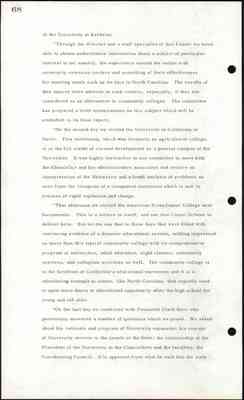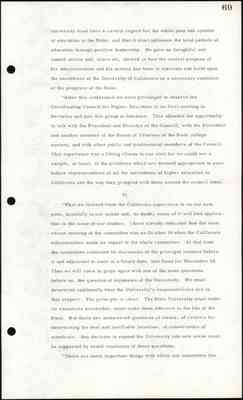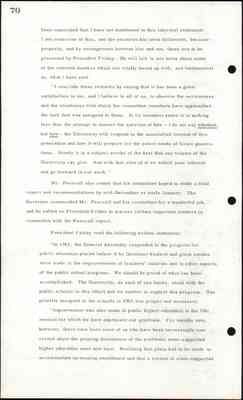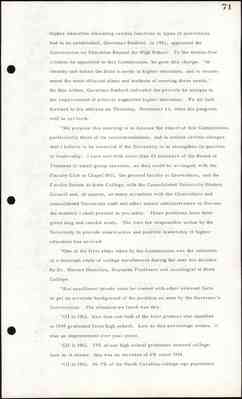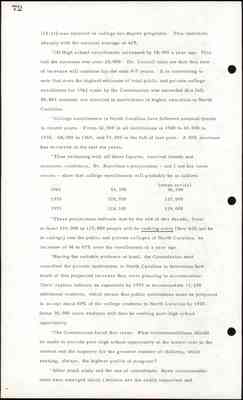Pages
68
of the University at Berkeley.
"Through the director and a staff specialist of this Center we were able to obtain authoritative information about a subject of particular interest to us; namely, the experience around the nation with university extension centers and something of their effectiveness for meeting needs such as we face in North Carolina. The results of this inquiry were adverse to such centers, especially, if they are considered as an alternative to community colleges. The committee has prepared a brief memorandum on this subject which will be embodied in its final report.
"On the second day we visited the University of California at Davis. This institution, which was formerly an agricultural college, is in the full stride of current development as a general campus of the University. It was highly instructive to our committee to meet with the Chancellor and his administrative associates and receive an interpretation of the University and a frank analysis of problems as seen from the viewpoint of a component institution which is now in process of rapid expansion and change.
"That afternoon we visited the American River Junior College near Sacramento. This is a lecture in itself, and one that I must forbear to deliver here. But let me say that in three days that were filled with convincing evidence of a dynamic educational system, nothing impressed us more than this typical community college with its comprehensive program of instruction, adult education, night classes, community services, and collegiate activities as well. The community college is in the forefront of California's educational movement and it is a stimulating example to states, like North Carolina, that urgently need to open more doors to educational opportunity after the high school for young and old alike.
"On the last day we conferred with President Clark Kerr who generously answered a number of questions which we posed. We asked about his rationale and program of University expansion; his concept of University service to the people of the State; the relationship of the President of the University to the Chancellors and the faculties; the Coordinating Council. It is apparent from what he said that the state
69
university must have a careful regard for the whole plan and system of education in the State, and that it must influence the total pattern of education through positive leadership. He gave us thoughtful and candid advice and, above all, showed us how the central purpose of his administration and his actions has been to maintain and build upon the excellence of the University of California as a necessary condition of the progress of the State.
"After this conference we were privileged to observe the Coordinating Council for Higher Education in its first meeting in Berkeley and join this group at luncheon. This afforded the opportunity to talk with the President and Director of the Council, with the President and another member of the Board of Trustees of the State college system, and with other public and professional members of the Council. This experience was a fitting climax to our visit for we could see a sample, at least, of the problems which are deemed appropriate to pass before representatives of all the institutions of higher education in California and the way they grappled with them around the council table.
VI
"What we learned from the California experience is on our notepads, hopefully in our minds and, no doubt, some of it will find application in the issue of our studies. I have already indicated that the most recent meeting of the committee was on October 14 when the California subcommittee made its report to the whole committee. At that time the committee continued its discussion of the principal matters before it and adjourned to meet at a future date, now fixed for November 18. Then we will come to grips again with one of the main questions before us, the question of expansion of the University. We must determine confidently what the University's responsibilities are in this respect. The principle is clear. The State University must make its resources accessible, must make them effective in the life of the State. But there are unanswered questions of means, of criteria for determining the best and justifiable locations, of conservation of standards. Any decision to expand the University into new areas must be supported by sound resolution of these questions.
"There are many important things with which our committee has
70
been concerned that I have not mentioned in this informal statement. I am conscious of this, and the omission has been deliberate, because properly, and by arrangement between him and me, these are to be presented by President Friday. He will talk to you today about some of the internal matters which are vitally bound up with, and fundamental to, what I have said.
"I conclude these remarks by saying that it has been a great satisfaction to me, and I believe to all of us, to observe the seriousness and the steadiness with which the committee members have approached the task that was assigned to them. In its broadest sense it is nothing less than the attempt to answer the question of how - I do not say whether, but how - the University will respond to the unsatisfied demand of this generation and how it will prepare for the patent needs of future generations. Surely it is a subject worthy of the best that any trustee of the University can give. And with that view of it we solicit your interest and go forward in our work."
Mr. Pearsall also stated that his committee hoped to make a final report and recommendations by mid-December or early January. The Governor commended Mr. Pearsall and his committee for a wonderful job, and he called on President Friday to discuss certain important matters in connection with the Pearsall report.
President Friday read the following written statement:
"In 1961, the General Assembly responded to the program for public education placed before it by Governor Sanford and great strides were made in the improvements of teachers' salaries and in other aspects of the public school program. We should be proud of what has been accomplished. The University, as each of you knows, stood with the public schools in this effort and we contine to support this program. The priority assigned to the schools in 1961 was proper and necessary.
"Improvement was also made in public higher education in the 1961 session for which we have expressed our gratitude. For months now, however, there have been some of us who have been increasingly concerned about the growing dimensions of the problems state-supported higher education must now face. Realizing that plans had to be made to accommodate increasing enrollment and that a system of state-supported
71
higher education allocating certain functions to types of institutions had to be established, Governor Sanford, in 1961, appointed the Commission on Education Beyond the High School. To the twenty-five citizens he appointed to this Commission, he gave this charge: "to identify and define the State's needs in higher education, and to recommend the most efficient plans and methods of meeting these needs." By this action, Governor Sanford indicated the priority he assigns to the improvement of publicly supported higher education. We all look forward to his address on Thursday, November 15, when his program will be set forth.
"My purpose this morning is to discuss the report of this Commission, particularly three of its recommendations, and to outline certain changes that I believe to be essential if the University is to strengthen its position of leadership. I have met with more than 45 members of the Board of Trustees in small group sessions, as they could be arranged; with the Faculty Club at Chapel Hill, the general faculty at Greensboro, and the Faculty Senate at State College; with the Consolidated University Student Council and, of course, on many occasions with the Chancellors and consolidated University staff and other senior administrators to discuss the matters I shall present to you today. given long and careful study. These problems have been The time for responsible action by the University to provide constructive and positive leadership in higher education has arrived.
"One of the first steps taken by the Commission was the initiation of a thorough study of college enrollments during the next two decades by Dr. Horace Hamilton, Reynolds Professor and sociologist at State College.
"But enrollment trends must be viewed with other relevant facts to get an accurate background of the problem as seen by the Governor's Commission.
The situation we faced was this:
"(1) In 1962, less than one-half of the first graders who enrolled in 1949 graduated from high school. Low as this percentage seems, it was an improvement over past years.
"(2) In 1961, 37% of our high school graduates entered college. Low as it seems, this was an increase of 6% since 1956.
"(3) In 1961, 26.9% of the North Carolina college-age population
72
(18-21) was enrolled in college for degree programs. This contrasts sharply with the national average of 42%.
"(4) High school enrollments increased by 18, 000 a year ago. This fall the increase was over 20,000. Dr. Carroll tells me that this rate of increase will continue for the next 5-7 years. It is interesting to note that even the highest estimate of total public and private college enrollment for 1962 made by the Commission was exceeded this fall. 80,804 students are enrolled in institutions of higher education in North Carolina.
"College enrollments in North Carolina have followed national trends in recent years. From 32,000 in all institutions in 1940 to 45,000 in 1950, 68,000 in I960, and 75,000 in the fall of last year. A 50% increase has occurred in the last six years.
"Thus reckoning with all these figures, survival trends and economic conditions, Dr. Hamilton's projections - and I use his mean series - show that college enrollments will probably be as follows
| (mean series) | ||
|---|---|---|
| 1965 | 93,300 | 96,000 |
| 1970 | 109,700 | 117.000 |
| 1975 | 124,100 | 139,000 |
"Having the reliable evidence at hand, the Commission next consulted the private institutions in North Carolina to determine how much of this projected increase they were planning to accommodate. Their replies indicate an expansion by 1970 to accommodate 11,250 additional students, which means that public institutions must be prepared to accept about 60% of the college students in North Carolina by 1970. Some 30,000 more students will then be seeking post-high school opportunity.
"The Commission faced this issue: What recommendations should be made to provide post-high school opportunity at the lowest cost to the student and the taxpayer for the greatest number of children, while seeking, always, the highest quality of program?
"After much study and the use of consultants, three recommendations have emerged which I believe are the really important and
